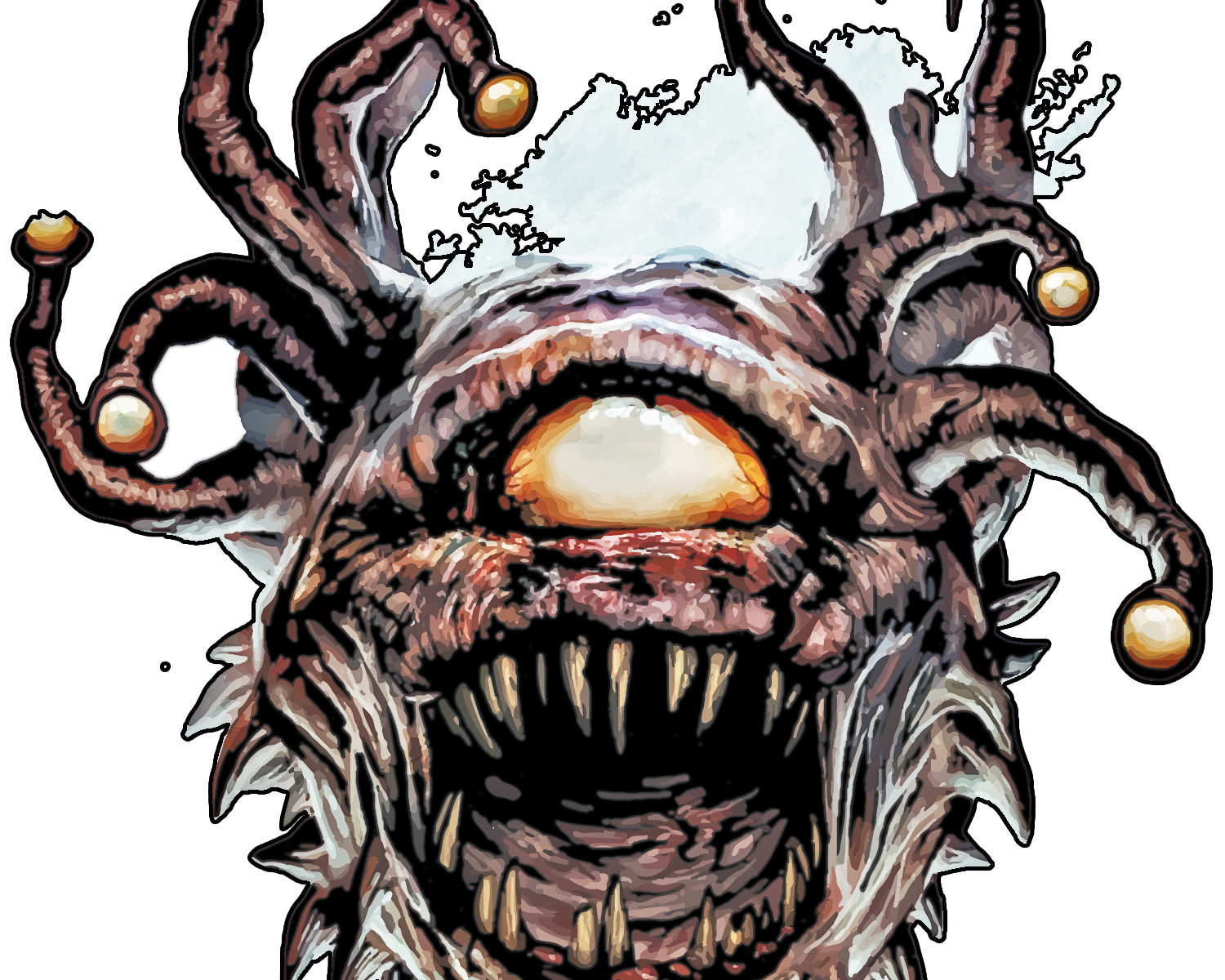Beholders in Dungeons and Dragons have been there from nearly the very beginning. They were first introduced into the Dungeons and Dragons game in the Greyhawk supplement in 1975. Every edition since then has included the Beholder as it has become one of the iconic monsters of the game. It is so unique, in fact, that it is probably included in more Dungeons and Dragons artwork than any other creature. They are so fearsome that every adventurer fears them. Their many eye stalks give them so much power that they can kill instantly. They are nearly always the boss of any dungeon where they might be found.
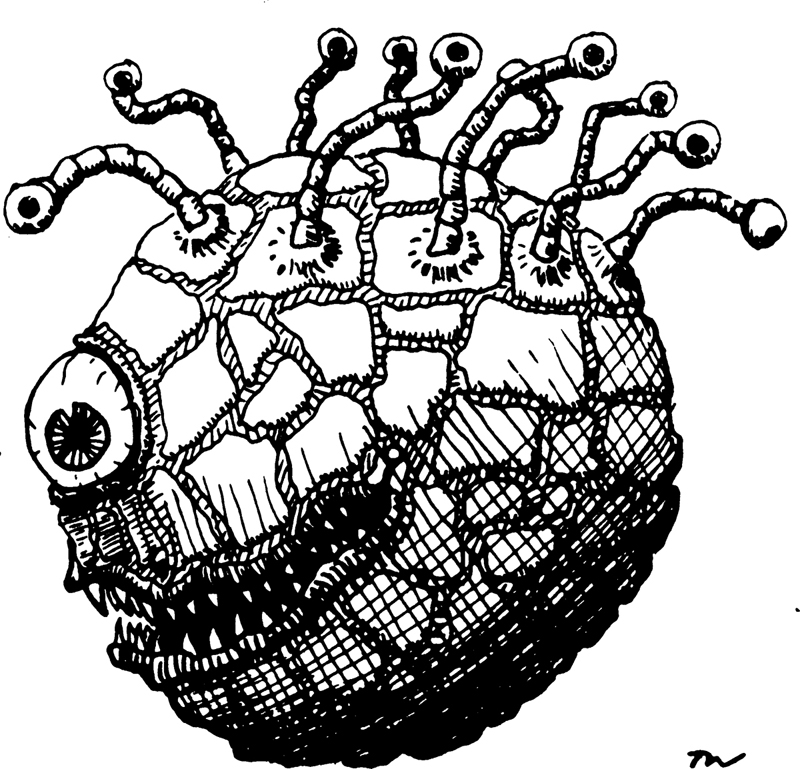
The huge central eye. The many wandering eye stalks. The big mouth with dozens of sharp teeth. And the floating mass with no legs. All of these things make a fearsome sight to someone exploring the great depths below the earth. Would you want to run into this guy?
Self Defense for Beholders in Dungeons and Dragons
All of that being said…..Beholders do have weaknesses. They do not have a huge number of hit points. Their armor class is not that difficult to hit depending upon which part of the creature you are targeting. So how does a supremely intelligent creature like this protect itself from harm?
Well for one thing….with up to eleven eyes it can see trouble coming from any direction. Surprise is unlikely to be an issue as it is looking everywhere all at once. It is also extremely intelligent. It is not likely to make mistakes. It is not likely to be duped. Beholders are planners. They are not likely to fail to foresee how adventurers might try to take it down. And it will have contingencies in the event that someone tries. It will have allies nearby as well as minions to serve it.
Beholders eat unintelligent foes and enslave intelligent ones to serve it’s evil needs. These creatures believe that they are at the top of the food chain and that all other creatures are inferior to it in power and intellect. And for the most part. They are right. Most creatures that they encounter will be less intelligent and less powerful. But adventurers are a different matter. Those with experience and magic can hurt a beholder or even slay it. And these creatures are fully aware of that potential danger.
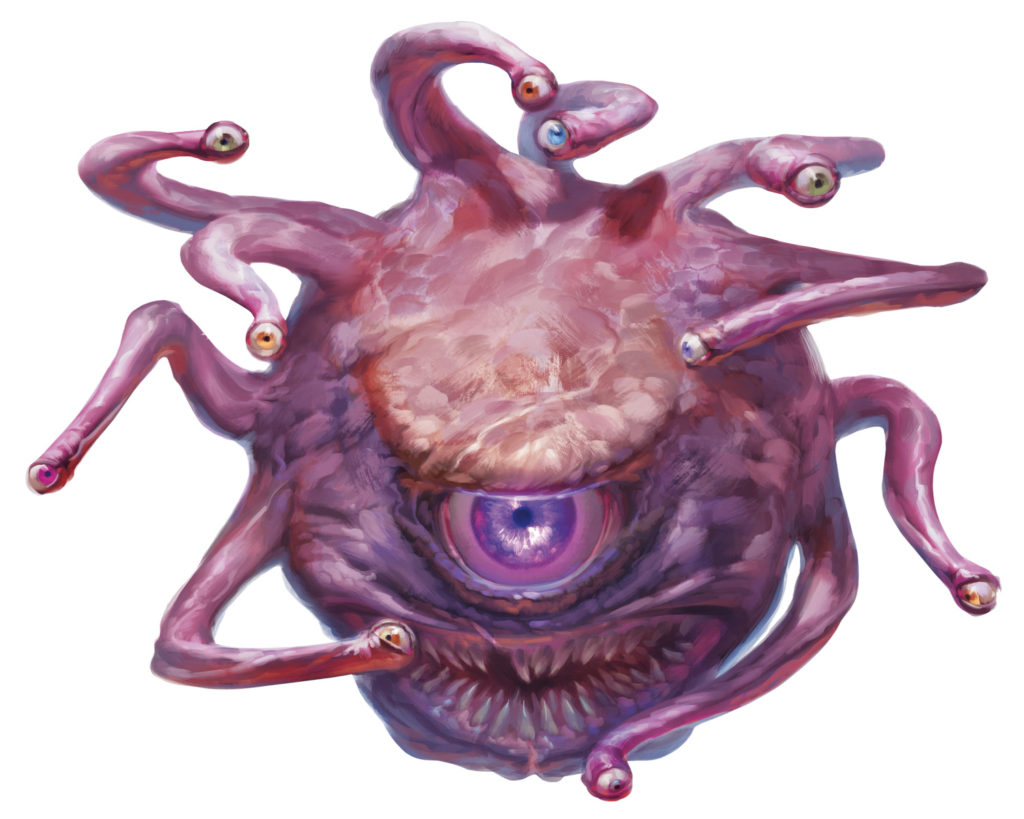
Range is the first thing that a Beholder is going to consider. The last thing that they want is a fighter to come up close and hack it in the face with a sword or axe. So they will find a way to keep range. Because they have the natural power to levitate they will use this to their advantage when necessary. Floating over lava, acid or other dangerous areas can keep anyone from getting up close and wacking it with a weapon. Floor traps such as spiked pits can also be placed in such a way that the Beholder can use them to it’s advantage for protection and to lure enemies to injure or kill themselves.
The central eye of the Beholder has the power to negate magic. This anti magic ray will be used liberally to reduce or eliminate the threat of magic being used against it effectively.
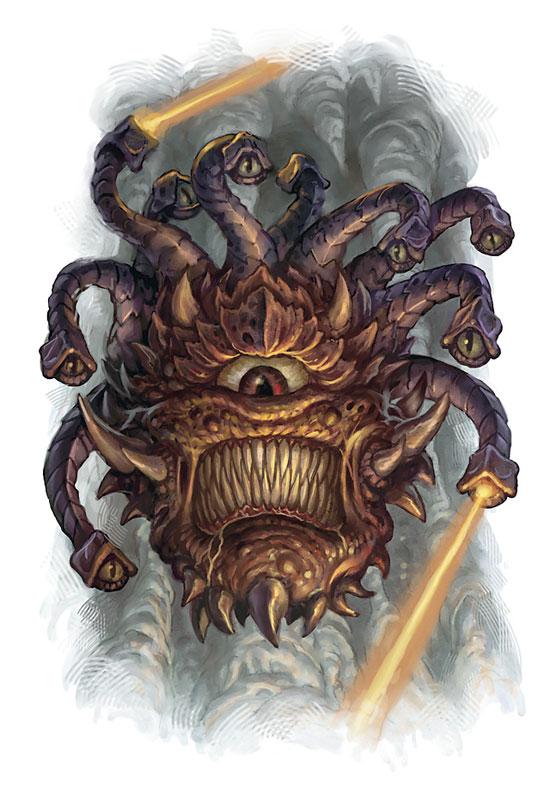
It has up to ten eyes. Each of those eyes has magical powers. Some of those powers are extremely deadly. These powers include:
- Disintegration Ray – It is pretty self-explanatory why this power is terrifying. Not only could the target die. It might not be able to be brought back by a resurrection or raise dead spell.
- Charm Person – The beholder could charm adventurers and then use them against their friends to protect itself
- Sleep – A sleeping enemy could be dispatched at a more convenient time
- Telekinese up to 2500 gp in weight – This could allow the beholder to pick up heavy objects and drop them on an opponent. Or it could allow the beholder to perhaps pick up an opponent and drop them into a pit of acid or spikes
- Flesh to stone – opponents turned to stone are no longer a threat
- Fear – terrified opponents flee or may sit frozen while their friends are slain
- Slow – slowed opponents will be firing or swinging at reduced speed
- Cause wounds – weakens it’s enemies
- Death Ray – slain enemies are good enemies to have
Of course, these, were the effects from 1st Edition. Other Editions may have modified these abilities a bit. But regardless of what edition that you play the Beholder knows it’s strengths and abilities and will use them to it’s advantage.
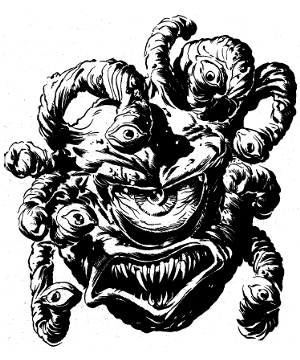
A Beholder is going to foresee that sooner or later an enemy will put it in danger. And it will take steps to protect itself from that possibility. It will have guards nearby. It may have guards nearby that are hidden in secret areas unseen to enemies who arrive in it’s lair. And if all else fails…..it may negotiate.
Beholders are evil and intelligent. But they are also practical. If they know that there is a danger that they might die. Then they will negotiate if necessary to avoid a confrontation that it does not think it will win. But they will almost always feel that they have the advantage. They will almost always think that their enemies will be the ones that need to pay a bribe to get away alive. But a wounded or near dying Beholder will realize it’s predicament and act accordingly.
In 5th Edition the Beholder will use it’s legendary actions which will increase the number of times per turn that it uses it’s eye rays. And that may be all the difference in winning or losing an encounter.
If all else fails….the Beholder will flee. It will almost always have escape tunnels nearby so that it can flee in the event of the worst happening. It is an intelligent creature. It will not rely on just one method of escape. There will usually be more than one such escape route. And those routes will likely be floor trapped in order to discourage pursuit. As it can fly right over such traps it will not be affected by them.
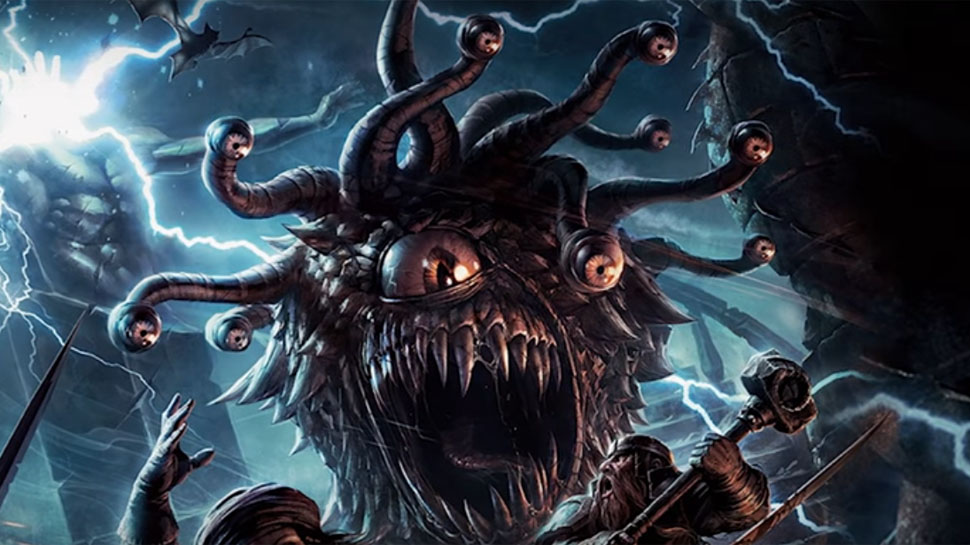
Beholders often have captives nearby. Those could be used for ransom or for threats against the adventurers who might pose a danger. There will usually be a cage or cell somewhere in the complex so that the Beholder can keep hostages. There may also be a torture chamber present so that it can extract useful information for it to use. Information is one of the tools that a Beholder relies on to dominate others.
Gas Spores are another line of defense for beholders. These look so similar to beholders they will almost always be attacked by adventurers who seek to destroy the Beholder. The Beholder knows this. And will use this to it’s advantage. Gas spores will explode when struck. This will do damage to all in the area of effect. It may also cause a chain of explosions if there are more than one gas spore present. This will weaken the adventurers who seek to destroy the Beholder.
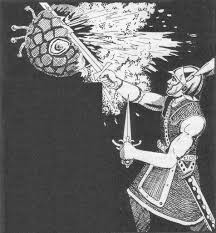
Not All Beholders in Dungeons and Dragons are the Same
There are many variations of the Beholder that exist in the game. Some of these Beholders are more or less powerful than the original. Some have different powers. Some are just distant relatives to the beholder but look rather similar. Some of these Beholders include:
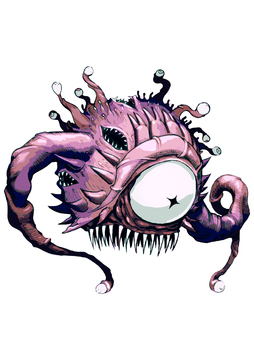
- Death Kiss – This creature is related to the Beholder but is not truly as fearsome despite it’s appearance. The tentacles of this creature are bloodsucking rather than magic using
- Eye of the Deep – This creature lives only at great depths of the ocean. It is possible, but not proven, that a fresh water version of this creature could exist. None have yet been discovered
- Gauth – This creature feeds on magic and has but six eye stalks
- Spectator – This neutral creature is often a guardian rather than an evil creature dominating others
- Death Tyrant – Even beholders die sometimes. And sometimes they are reborn as something far worse. The Death Tyrant is an undead version of the Beholder
- Hive Mother – These creatures are legendary. No one who has ever actually seen one has returned alive to describe them. But there are ancient books and tomes that describe these creatures as being enormous. So enormous that they can no longer float without assistance. Often they prop themselves on a pillow atop an ornate pedestal so that they can control the actions of other beholders around them.
- Director – Unlike other Beholders these warriors use a mount. This mount is usually a crawler which is essentially a cross between a spider and a centipede. Large of course.
- Examiner – These neutral beholders are often scholars. They do magical research and protect archives.
- Lensman – This creature does not really look much like a beholder. But it is related to them. Instead of a floating ball it is a humanoid form with an enormous eye in the center of it’s chest. They are usually minions and not leaders
- Overseer – These also do not look much like a normal beholder. They appear more like a tree. Each of it’s thirteen limbs has a small eye at the end of it. And these eyes have powers.
- Watcher – These neutral beholders are information gatherers and are not typically brave.
As most players are very familiar with the Beholder, and it’s various powers, you might want to mix things up a bit. There is no reason that every Beholder has to be the same at all. As you can tell from the huge amount of artwork out there that all Beholders do not look the same at all. So there is no reason that they have to be. It is quite possible that some have more eye stalks than others. Losing eye stalks in combat happens. But it is possible that some might possess eye stalks with different powers. Or perhaps their central eye might have different powers.
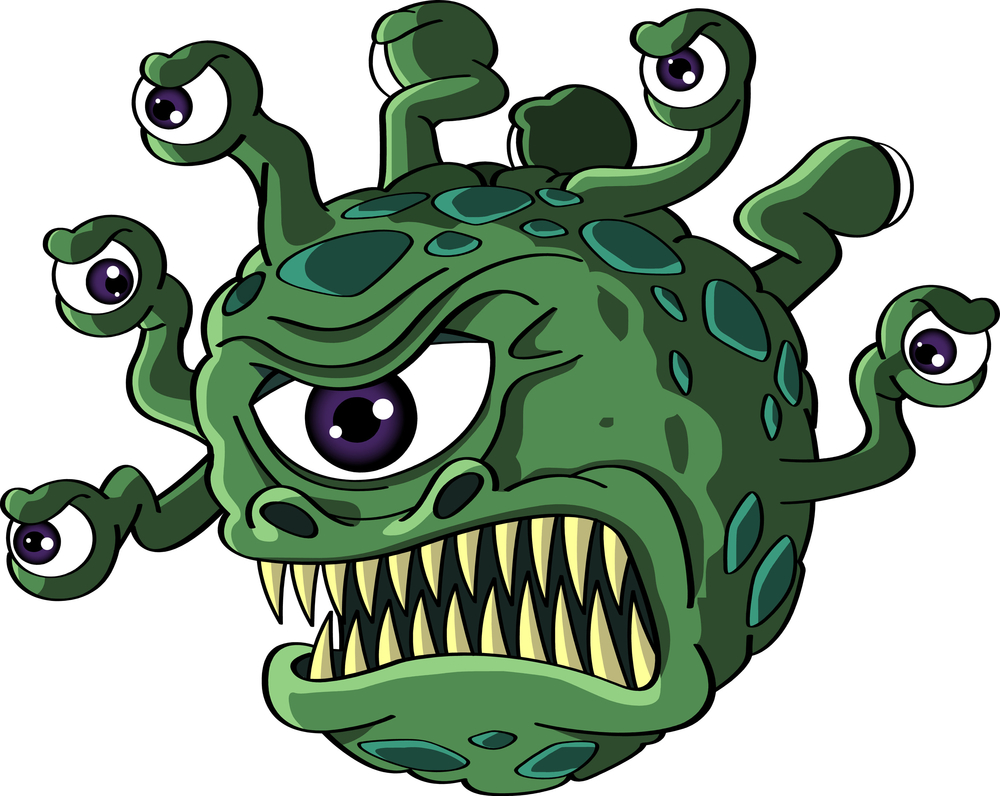
Some suggestions for different central eye powers:
- Prismatic spray
- Destruction (reverse of resurrection)
- Power word kill
- Mass charm
- Mass suggestion
Some suggestions for alternate eye stalk powers:
- Harm (reverse of heal)
- Flame strike
- Fire storm
- Feeble mind
- Cone of cold
- Confusion
- Suggestion
- Illusion
- Power word stun
- Teleport
- Charm monster
- Hold person
- Dispel magic
- Dispel good
Substitute some of these powers for the standard powers of a Beholder and your players will not know what just hit them. They will be confused and terrified. They will not know how to react to such a different and alien creature. And that is the point of it. A beholder should be alien to them.
Lairs of Beholders in Dungeons and Dragons
Beholder lairs, of course, are not all alike. That would be a mistake that a super intelligent creature like this would never make. The last thing that they would want is for anyone to be too familiar with their methods and defenses.
As mentioned previously it will have escape tunnels set up in multiple places. And it will have traps set up or nasty things for it to float over during combat. But the other parts of a Beholder lair are not always similar. But there are some components that are frequently found in a Beholder lair:
- Trophy Room – As the most dominant member of the social order the Beholder will often want trophies of it’s conquests. Such trophies might be taxidermy of slain adventurers or it might be mere treasures from that encounter. A gallery of heads would not be unusual to find in such a dismal place.
- Art Work – As intelligent creatures the Beholder appreciates the fine things in life even if it cannot enjoy all of them the same way a human could. Paintings, sculptures and other art work might be placed in one area where the Beholder could enjoy such works.
- Alarms – The Beholder does not like surprises. It’s many eyes make that difficult anyway but it will want to know right away when enemies are present in the lair
- Secret Passages – The Beholder will want to have access to all areas of the lair without risk of being caught traveling in an open hall where it could be ambushed. It will have passages that only it knows about and even it’s minions do not.
- Multi-Leveled Lairs – when you can float…..stairs are unnecessary. And why limit oneself to a single level. Passage ways that end in a shaft, upwards or downwards, would not be unexpected in such a place
- Spy holes – A beholder has many eyes. It will want to see what is going on around it. And it will not fully trust even it’s closest minions
- Jail Cells – for hostages and prisoners
- Torture Chamber – for extracting useful information
- Safe Room – when all else fails a place to run to is wise to have
- Treasure Chamber – some treasures need to be kept safe from prying eyes
These will not all be present in every Beholder lair but may be present in any of them. Perhaps all of these and more will be present. Beholders alone know their needs. And not all of them have the same needs.
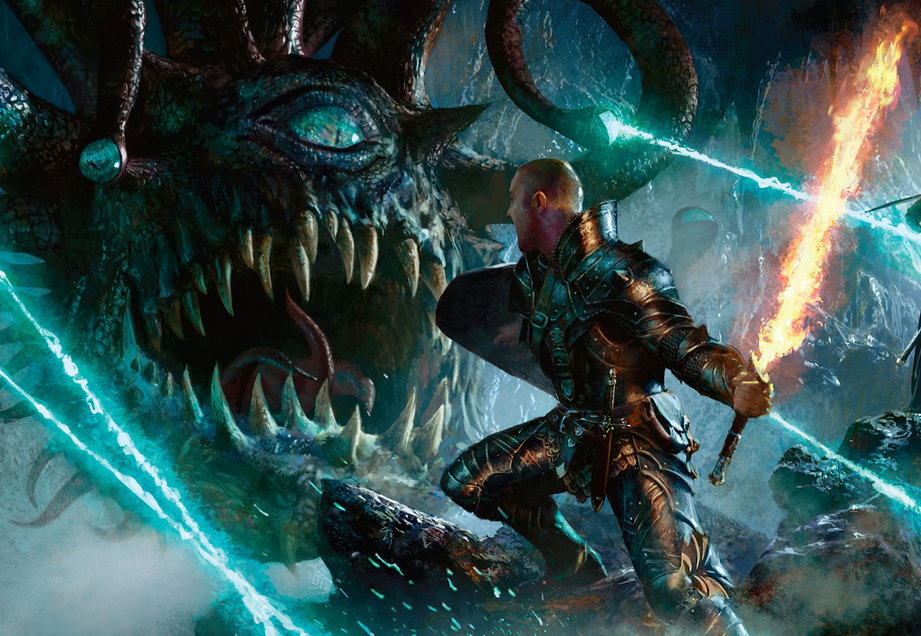
Beholders in Dungeons and Dragons Are Evil
Most Beholders in Dungeons and Dragons are evil. There are exceptions, of course, as indicated above in the list of variant Beholders. But most are evil. They have evil designs and may be the primary villain in a campaign. They enjoy manipulating and dominating others for their enjoyment. They enjoy tormenting and torturing their enemies. And they love to accumulate trophies and treasures taken from others.
Defeating a Beholder in Dungeons and Dragons
For adventurers to defeat such a creature they must be either lucky or good at what they do. Great care must be taken to avoid the effects of the many powers of this creature. One must also avoid the traps and the minions and guardians of such creatures. This takes a powerful group of adventurers to have any chance at success. And the successful destruction of a Beholder is the kind of thing sung about by Bards in taverns all over the realm when it is done.



